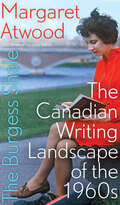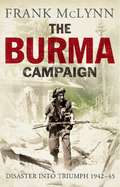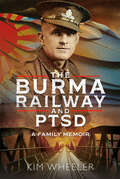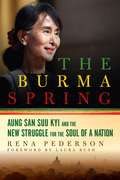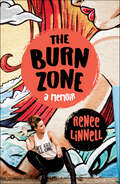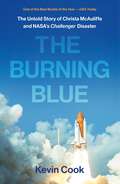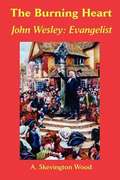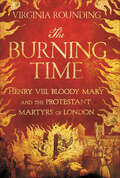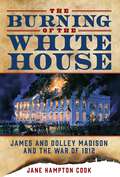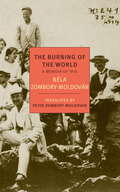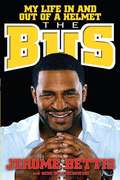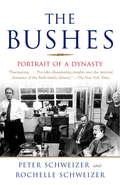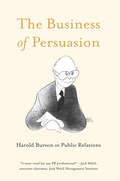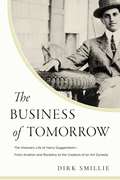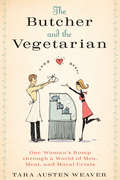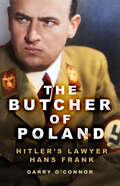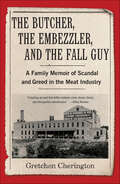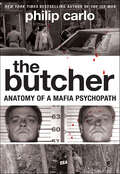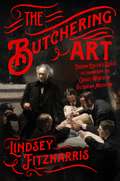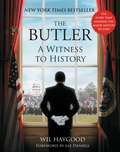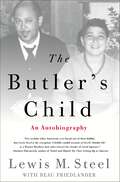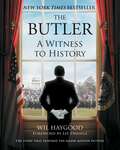- Table View
- List View
The Burgess Shale: The Canadian Writing Landscape of the 1960s (The CLC Kreisel Lecture Series)
by Margaret Atwood“Atwood provides a window into her own early writing days . . . a treasure for readers interested in Canadian literature because this is where it all began.” —Prairie Fire Review of Books“The outburst of cultural energy that took place in the 1960s was in part a product of the two decades that came before. It’s always difficult for young people to see their own time in perspective: when you’re in your teens, a decade earlier feels like ancient history and the present moment seems normal: what exists now is surely what has always existed.”In this short work, Margaret Atwood, author of The Handmaid’s Tale and “Canada’s most famous writer” (The New Yorker), compares the Canadian literary landscape of the 1960s to the Burgess Shale, a geological formation that contains the fossils of many strange prehistoric life forms. The Burgess Shale is not entirely about writing itself, however: Atwood also provides some insight into the meager writing infrastructure of that time, taking a lighthearted look at the early days of the institutions we take for granted today—from writers’ organizations, prizes, and grant programs to book tours and festivals.“Allows the reader a brief glimpse into the mind of a great writer and her perspective and experience living through what would now seem to many the Stone Age of the Canadian writing scene . . . invaluable and very readable.” —Canadian Literature
The Burma Campaign: Disaster Into Triumph, 1942 – 45 (The Yale Library of Military History)
by Frank McLynnThis history reveals the failures and fortunes of leadership during the WWII campaign into Japanese-occupied Burma: &“a thoroughly satisfying experience&” (Kirkus). Acclaimed historian Frank McLynn tells the story of four larger-than-life Allied commanders whose lives collided in the Burma campaign, one of the most punishing and protracted military adventures of World War II. This vivid account ranges from Britain&’s defeat in 1942 through the crucial battles of Imphal and Kohima—known as "the Stalingrad of the East"—and on to ultimate victory in 1945. Frank McLynn narrative focuses on the interactions and antagonisms of its principal players: William Slim, the brilliant general; Orde Wingate, the idiosyncratic commander of a British force of irregulars; Louis Mountbatten, one of Churchill's favorites, overpromoted to the position of Supreme Commander, S.E. Asia; and Joseph "Vinegar Joe" Stilwell, a hard-line—and openly anlgophobic—U.S. general. With lively portraits of each of these men, McLynn shows how the plans and strategies of generals and politicians were translated into a hideous reality for soldiers on the ground.
The Burma Railway and PTSD: A Family Memoir
by Kim WheelerMany books and memoirs have been written on prisoner of war captivity in the Far East during the Second World War. Some contain incredible detail concerning the fall of Singapore and are full of military historical facts. This book is not like that. Instead, it is written from the viewpoint of a young girl who experienced the bittersweet homecoming of her traumatized father, Jack, following the end of the war. June and her mother, Beatrice, had lovingly prepared for Jack’s long-awaited return from his imprisonment at the hands of the Japanese out in the Far East. June recounts that they quickly realized how ill-prepared they were to deal with Jack’s post-war traumas. The man who returned home did not resemble the man who had left in 1941. It proved to be a troubled journey as they navigated a path back to a semblance of normal family life. Their only way to cut through Jack’s decompression from three and a half years of intensely cruel mental stress in the notorious POW camps was by exercising incredible patience and, ultimately, talking it through with brutal honesty. Jack was not a man who would have sought out help, especially concerning how he felt inside. Today, we comfortably talk about mental health and, in Jack’s case, PTSD. Following recent conflicts across the world, the topic of mental suffering has been thrown wide open. It has become part of our everyday language and is viewed with compassion. There is no shame in any type of mental health issue. However, June admitted that thirty years ago she would have been nervous to put her story down on paper. We are now acutely aware of what those unfortunate returning prisoners of war were suffering back in 1945. There is no shame to call out what it was – Post-Traumatic Stress Disorder (PTSD). This was a psychological trauma gained in horrific circumstances. Invisible injuries that became imprinted on minds. The military and government put the traumatized returning prisoners of war under immense pressure not to speak of their experiences in captivity. Sadly, many of them took the instruction seriously and never discussed it with their families or friends. The message that had been conveyed was that they were nothing more than an embarrassing inconvenience. Jack recalled how they were told Britain was over the war and that people were moving on with their lives. No one would be interested in their tales of horror and, indeed, they may not even have believed them. Jack told us they were given leaflets concerning the matter on board their repatriation ships as they sailed homewards. Those returning POWs had already been dubbed The Forgotten Army, and then they were told to just disappear into society without recognition.
The Burma Spring: Aung San Suu Kyi and the New Struggle for the Soul of a Nation
by Rena PedersonAung San Suu Kyi--Burma's "woman of destiny" and one of the most admired voices for freedom in the world today--comes alive through this brilliant rendering of Burma's tumultuous history Award-winning journalist and former State Department speechwriter Rena Pederson brings to light fresh details about the charismatic Nobel Peace Prize winner Aung San Suu Kyi: the inspiration for Burma's (now Myanmar) first steps towards democracy. Suu Kyi's party will be a major contender in the 2015 elections, a revolutionary breakthrough after years of military dictatorship. Using exclusive interviews with Suu Kyi since her release from fifteen years of house arrest, as well as recently disclosed diplomatic cables, Pederson uncovers new facets to Suu Kyi's extraordinary story. The Burma Spring will also surprise readers by revealing the extraordinary steps taken by First Lady Laura Bush to help Suu Kyi, and also how former Secretary of State Hillary Clinton injected new momentum into Burma's democratic rebirth. Pederson provides a never before seen view of the harrowing hardships the people of Burma have endured and the fiery political atmosphere in which Suu Kyi's has fought a life-and-death struggle for liberty in this fascinating part of the world.
The Burn Zone: A Memoir
by Renee LinnellAfter seven years of faithfully following her spiritual teacher, Renee Linnell finally realized she was in a cult and had been severely brainwashed. But how did that happen to someone like her? She had graduated magna cum laude with a double degree. She had traveled to nearly fifty countries alone before she turned thirty-five. She was a surf model and a professional Argentine tango dancer. She had started five different companies and had an MBA from NYU. How could someone like her end up brainwashed and in a cult? The Burn Zone is an exploration of how we give up our power―how what started out as a need to heal from the loss of her parents and to understand the big questions in life could leave a young woman fighting for her sanity and her sense of self. In the years following her departure from the cult, Linnell struggled to reclaim herself, to stand in her truth, and to rebuild her life. And eventually, after battling depression and isolation, she found a way to come out the other side stronger than ever. Part inspirational story, part cautionary tale, this is a memoir for spiritual seekers and those who feel lost in a world that makes them feel less than perfect.
The Burning Blue: The Untold Story of Christa McAuliffe and NASA's Challenger Disaster
by Kevin CookThe untold story of a national trauma—NASA’s Challenger explosion—and what really happened to America’s Teacher in Space, illuminating the tragic cost of humanity setting its sight on the starsYou’ve seen the pictures. You know what happened. Or do you?On January 28, 1986, NASA’s space shuttle Challenger exploded after blasting off from Cape Canaveral. Christa McAuliffe, America’s “Teacher in Space,” was instantly killed, along with the other six members of the mission. At least that's what most of us remember.Kevin Cook tells us what really happened on that ill-fated, unforgettable day. He traces the pressures—leading from NASA to the White House—that triggered the fatal order to launch on an ice-cold Florida morning. Cook takes readers inside the shuttle for the agonizing minutes after the explosion, which the astronauts did indeed survive. He uncovers the errors and corner-cutting that led an overconfident space agency to launch a crew that had no chance to escape.But this is more than a corrective to a now-dimming memory. Centering on McAuliffe, a charmingly down-to-earth civilian on the cusp of history, The Burning Blue animates a colorful cast of characters: a pair of red-hot flyers at the shuttle's controls, the second female and first Jewish astronaut, the second Black astronaut, and the first Asian American and Buddhist in space. Drawing vivid portraits of Christa and the astronauts, Cook makes readers forget the fate they're hurtling toward. With drama, immediacy, and shocking surprises, he reveals the human price the Challenger crew and America paid for politics, capital-P Progress, and the national dream of "reaching for the stars."
The Burning Heart: Evangelist
by Arthur Skevington WoodHere in this classic work A. Skevington Wood has the advantage of the British perspective and yet he provides a reliable interpretation of Wesley's own theological thinking. Wood also rightly notes that the key to understanding Wesley is to see him as an evangelist. This interpretative theme is the prism for seeing the whole Wesley. Wood's profound appreciation for Wesley allows him to penetrate insightfully into the central concerns and contributions of Wesley. The decisive contribution of this book is that it gives the reader a clear and straightforward account of the ancestry, life, and theology of John Wesley and it does so all in one volume.
The Burning Time: Henry VIII, Bloody Mary and the Protestant Martyrs of London
by Virginia RoundingSmithfield, settled on the fringes of Roman London, was once a place of revelry. Jesters and crowds flocked for the medieval St Bartholomew's Day celebrations, tournaments were plentiful and it became the location of London's most famous meat market. Yet in Tudor England, Smithfield had another, more sinister use: the public execution of heretics.The Burning Time is a vivid insight into an era in which what was orthodoxy one year might be dangerous heresy the next. The first martyrs were Catholics, who cleaved to Rome in defiance of Henry VIII's break with the papacy. But with the accession of Henry's daughter Mary - soon to be nicknamed 'Bloody Mary' - the charge of heresy was leveled against devout Protestants, who chose to burn rather than recant.At the center of Virginia Rounding's vivid account of this extraordinary period are two very different characters. The first is Richard Rich, Thomas Cromwell's protégé, who, almost uniquely, remained in a position of great power, influence and wealth under three Tudor monarchs, and who helped send many devout men and women to their deaths. The second is John Deane, Rector of St Bartholomew's, who was able, somehow, to navigate the treacherous waters of changing dogma and help others to survive.The Burning Time is their story, but it is also the story of the hundreds of men and women who were put to the fire for their faith.
The Burning of the White House: James and Dolley Madison and the War of 1812
by Jane Hampton CookIt's unimaginable today, even for a generation that saw the Twin Towers fall and the Pentagon attacked. It's unimaginable because in 1814 enemies didn't fly overhead, they marched through the streets; and for 26 hours in August, the British enemy marched through Washington, D.C. and set fire to government buildings, including the U.S. Capitol and the White House.Relying on first-hand accounts, historian Jane Hampton Cook weaves together several different narratives to create a vivid, multidimensional account of the burning of Washington, including the escalation that led to it and the immediate aftermath. From James and Dolley Madison to the British admiral who ordered the White House set aflame, historical figures are brought to life through their experience of this unprecedented attack. The Burning of the White House is the story of a city invaded, a presidential family displaced, a nation humbled, and an American spirit that somehow remained unbroken.
The Burning of the World
by Bela Zombory-Moldovan Peter Zombory-MoldovanPublishing during the 100th Anniversary of the First World War An NYRB Classics Original The budding young Hungarian artist Béla Zombory-Moldován was on holiday when the First World War broke out in July 1914. Called up by the army, he soon found himself hundreds of miles away, advancing on Russian lines and facing relentless rifle and artillery fire. Badly wounded, he returned to normal life, which now struck him as unspeakably strange. He had witnessed, he realized, the end of a way of life, of a whole world. Published here for the first time in any language, this extraordinary reminiscence is a powerful addition to the literature of the war that defined the shape of the twentieth century.
The Bus
by Jerome Bettis Gene WojciechowskiBettis tells his full, unvarnished story for the first time--from his sometimes troubled childhood in inner-city Detroit to his difficult transition at Notre Dame to a trade for the ages that resulted in 10 glorious seasons with the Pittsburgh Steelers.
The Bush Administrations and Saddam Hussein
by Alex Roberto Hybel Justin Matthew KaufmanThe authors present a vital analysis of the foreign policy-making processes of the two Bush administrations prior to the attacks on Iraq. In a thorough comparison, they show how both presidents used historical analogies to evaluate information, relied on instinct to formulate decisions, and drew on moral language to justify their choices.
The Bush Tragedy
by Jacob WeisbergThis is the book that cracks the code of the Bush presidency. Unstintingly yet compassionately, and with no political ax to grind, Slate editor in chief Jacob Weisberg methodically and objectively examines the family and circle of advisers who played crucial parts in George W. Bush's historic downfall.In this revealing and defining portrait, Weisberg uncovers the "black box" from the crash of the Bush presidency. Using in-depth research, revealing analysis, and keen psychological acuity, Weisberg explores the whole Bush story. Distilling all that has been previously written about Bush into a defining portrait, he illuminates the fateful choices and key decisions that led George W., and thereby the country, into its current predicament. Weisberg gives the tragedy a historical and literary frame, comparing Bush not just to previous American leaders, but also to Shakespeare's Prince Hal, who rises from ne'er-do-well youth to become the warrior king Henry V.Here is the bitter and fascinating truth of the early years of the Bush dynasty, with never-before-revealed information about the conflict between the two patriarchs on George W.'s father's side of the family-the one an upright pillar of the community, the other a rowdy playboy-and how that schism would later shape and twist the younger George Bush; his father, a hero of war, business, and Republican politics whose accomplishments George W. would attempt to copy and whose absences he would resent; his mother, Barbara, who suffered from insecurity, depression, and deep dissatisfaction with her role as housewife; and his younger brother Jeb, seen by his parents as steadier, stronger, and the son most likely to succeed.Weisberg also anatomizes the replacement family Bush surrounded himself with in Washington, a group he thought could help him correct the mistakes he felt had destroyed his father's presidency: Karl Rove, who led Bush astray by pursuing his own historical ambitions and transforming the president into a deeply polarizing figure; Dick Cheney, whose obsessive quest to restore presidential power and protect the country after 9/11 caused Bush and America to lose the world's respect; and, finally, Donald Rumsfeld and Condoleezza Rice, who encouraged Bush's foreign policy illusions and abetted his flight from reality. Delving as no other biography has into Bush's religious beliefs-which are presented as at once opportunistic and sincere-The Bush Tragedy is an essential work that is sure to become a standard reference for any future assessment. It is the most balanced and compelling account of a sitting president ever written.From the Hardcover edition.
The Bushes
by Peter Schweizer Rochelle SchweizerGet the inside story on America's most powerful political dynasty. President George W. Bush leads our nation in a time of unprecedented peril. But how well do we really know him or his remarkable family, whose history often mirrors the history of America? Now, in the first full-scale biography of the Bushes, Peter and Rochelle Schweizer trace the extraordinary trajectory of their rise to power. Through a series of exclusive, surprisingly candid interviews with members of the family and close friends, the inner workings of this very private family are revealed: their marriages and friendships; the intense sibling rivalry between George W. and Jeb Bush; divisions between father and son over the Iraq war; even Jeb Bush's plans to run for president in 2008. Never-before-seen private photos add even greater detail and depth to this fascinating family portrait. And above all, we see George W. Bush the way his family does, as an intensely driven person who has a much more complex relationship with his father than has often been portrayed in the media. Family members talk about how he deals with the stresses of the war on terrorism, why he sees it as a "religious war," and how his personal faith influences what he says and does. The Schweizers also delve into the Bushes' sensitive and secret business dealings, including their long history of involvement in the oil business. Their shrewd alliances with other American dynasties--including the Kennedys, Rockefellers, and Tafts--have all helped to quietly consolidate their power within the Republican Party. Indeed, what makes the Bushes so successful is that they function less like the great political families before them and more like a high-tech startup: free-flowing, pragmatic, and opportunistic. It is this distinction that assures them an enduring presence on the nation's political stage, making The Bushes essential reading for anyone who cares about America's future.
The Business of Persuasion: Harold Burson on Public Relations
by Harold Burson&“A wonderfully personal account of the thoughts behind a lifelong focus on the reputation of corporations around the world. Candid and straightforward.&”—Huffington Post Harold Burson, described by PRWeek as &“the [20th] century&’s most influential PR figure,&” is perhaps the most recognized name in the industry today. The founder of PR giant Burson-Marsteller had an incredible 70-year career, in which he built a global enterprise from a one-man consulting firm. In this illuminating and engaging business memoir, Burson traces his career from studying at Ole Miss to serving in World War II, reporting on the Nuremburg trials, and joining with Bill Marsteller. Together, he and Marsteller made history in a new venture that would grow to be one of the biggest public relations companies in the world, with over 60 offices on six continents. By way of personal and professional examples, Burson shows readers what public relations really entails—its challenges, methodologies, and impacts. His anecdotes on PR challenges like the &“Tylenol crisis,&” the removal of confederate flags from Ole Miss, and the introduction of &“New Coke&” illustrate Burson&’s time-tested tenets of great PR and crisis management. He interweaves iconic moments from the history of public relations into his story, making this &“a must-read for any PR professional&” (Jack Welch, executive chairman, Jack Welch Management Institute). &“Every detail of Harold&’s professional life is brought alive through an interesting narrative of the highs and lows . . . There is loads of inspiration hidden in every page for everyone. Be it a reader with no interest in Public Relations or a veteran who wants to understand more about the profession.&”—Reputation Today
The Business of Tomorrow: The Visionary Life of Harry Guggenheim: From Aviation and Rocketry to the Creation of an Art Dynasty
by Dirk SmillieA veteran Forbes journalist brings to life the brilliant and complex Harry Guggenheim in the first-ever biography on this groundbreaking American figure.At the turn of the last century, the Guggenheim family ran the most powerful mining conglomerate on earth. Decades later came the Guggenheim museum, which became the hub of the world&’s most powerful art brand. In between, the Guggenheim name was uttered in every field from aviation to politics, from journalism to rocketry. But who was behind this epic sphere of influence? It took three generations of Guggenheims to build the wealth in its first era. Yet it was the singular force of Harry Guggenheim who would guide the family&’s next generation of businesses into modernity. Part angel investor, part entrepreneur, part technologist, Harry launched businesses whose impact on 20th century America went far beyond the Guggenheims&’ mines or museum. His visionary investments continue to profoundly influence our world and hold valuable business lessons for billionaire dynasty builders like Jeff Bezos and Elon Musk. A flawed but brilliant man, Harry Guggenheim was the confidante to five American presidents and a key financial force behind commercial aviation and space exploration, two innovations that catapulted the nation into the future. With unprecedented archival access, Dirk Smillie astutely examines Harry&’s business acumen, intellectual curiosities, and the world he lived in. Whether it was his paradoxical friendship with Charles Lindbergh or his dynamic and ambitions family members, Smillie puts Harry&’s life and work in rich context. Epic and intimate, The Business of Tomorrow reveals the fascinating life of an American icon.
The Butcher and the Vegetarian: One Woman's Romp Through a World of Men, Meat, and Moral Crisis
by Tara Austen WeaverGrowing up in a family that kept jars of bean sprouts on its windowsill before such things were desirable or hip, Tara Austen Weaver never thought she'd stray from vegetarianism. But as an adult, she found herself in poor health, and, having tried cures of every kind, a doctor finally ordered her to eat meat. Warily, she ventured into the butcher shop, and as the man behind the counter wrapped up her first-ever chicken, she found herself charmed. Eventually, he dared her to cook her way through his meat counter. As Tara navigates through this new world—grass-fed beef vs. grain-fed beef; finding chickens that are truly free-range—she's tempted to give up and go back to eating tempeh. The more she learns about meat and how it's produced, and the effects eating it has on the human body and the planet, the less she feels she knows. She embarks upon a sometimes hilarious, sometimes frightening whirlwind tour that takes her from slaughterhouse to chef's table, from urban farm to the hearthside of cow wranglers. Along the way, she meets an unforgettable cast of characters who all seem to take a vested interest in whether she opts for turnips or T-bones. The Butcher and the Vegetarian is the rollicking and relevant story of one woman's quest to reconcile a nontraditional upbringing with carnal desires.
The Butcher of Poland: Hitler's Lawyer Hans Frank
by Garry O'ConnorThe life of the Bavarian Hans Frank, one of the ten war criminals hanged at Nuremburg in 1946, who converted to Catholicism before he died, has not received the full attention the world has given to other Nazi leaders. In many ways he warrants it more. His life symbolises Germany's hubristic and visionary ambition to an alarming degree much better than anyone else's, perhaps because he was an intellectual of the highest calibre: ‘Can’t they see,’ he said of his fellow accused at Nuremberg, ‘that this is a horrible tragedy in the history of mankind, and that we are the symbols of an evil that God is brushing aside?’ As he recognised by the end he was a primary - if not the exemplary - symbol of evil, his remorse, self-pity, and arrogance knew no bounds as they vied with his contrition.Author Garry O'Connor brings his skills as a playwright, biographer and novelist to this harrowing account of Histler's lawyer, the man who formalised the Nazi race laws.
The Butcher, the Embezzler, and the Fall Guy: A Family Memoir of Scandal and Greed in the Meat Industry
by Gretchen CheringtonThree powerful men converge on the banks of the Red Cedar River in the early 1900s in southern Minnesota—George Albert Hormel, founder of what will become the $10 billion food conglomerate Hormel Foods; Alpha LaRue Eberhart, the author’s paternal grandfather and Hormel’s Executive Vice President and Corporate Secretary; and Ransome Josiah Thomson, Hormel’s comptroller. Over ten years, Thomson will embezzle $1.2 million from the company’s coffers, nearly bringing the company to its knees.The Butcher, The Embezzler, and The Fall Guy opens in 1922 as George Hormel calls Eberhart into his office and demands his resignation. Hailed as the true leader of the company he’d helped Hormel build—is Eberhart complicit in the embezzlement? Far worse than losing his job and the great wealth he’d rightfully accumulated is that his beloved young wife, Lena, is dying while their three children grieve alongside. Of course, his story doesn’t end there. In scale both intimate and grand, Cherington deftly weaves the histories of Hormel, Eberhart, and Thomson within the sweeping landscape of our country’s early industries, along with keen observations about business leaders gleaned from her thirty-five-year career advising top company executives. The Butcher, The Embezzler, and The Fall Guy equally chronicles Cherington’s journey from blind faith in family lore to a nuanced consideration of the three men’s great strengths and flaws—and a multilayered, thoughtful exploration of the ways we all must contend with the mythology of powerful men, our reverence for heroes, and the legacy of a complicated past.
The Butcher: Anatomy of a Mafia Psychopath
by Philip CarloThe New York Times bestselling author of Gaspipe and The Ice Man, Phillip Carlo returns with a hair-raising portrait of arguably the most depraved psychopath in the history of the Mafia, mob enforcer Tommy “Karate” Pitera. The Butcher tells the riveting true story of a hit man who loved his work too much—a maniac believed responsible for more than sixty remarkably brutal murders—whom even organized crime’s most cold-blooded assassins feared. Another riveting journey into the darkest corners of the underworld, Carlo’s The Butcher is destined to be a true crime classic alongside Wiseguys by Nicholas Pileggi and Underboss by Peter Maas.
The Butchering Art: Joseph Lister's Quest to Transform the Grisly World of Victorian Medicine
by Lindsey Fitzharris"Warning: She spares no detail!" —Erik Larson, bestselling author of Dead Wake A Top 10 Science Book of Fall 2017, Publishers Weekly"Fascinating and shocking." —Kirkus Reviews (starred review)The gripping story of how Joseph Lister’s antiseptic method changed medicine foreverIn The Butchering Art, the historian Lindsey Fitzharris reveals the shocking world of nineteenth-century surgery on the eve of profound transformation. She conjures up early operating theaters—no place for the squeamish—and surgeons, working before anesthesia, who were lauded for their speed and brute strength. These medical pioneers knew that the aftermath of surgery was often more dangerous than their patients’ afflictions, and they were baffled by the persistent infections that kept mortality rates stubbornly high. At a time when surgery couldn’t have been more hazardous, an unlikely figure stepped forward: a young, melancholy Quaker surgeon named Joseph Lister, who would solve the deadly riddle and change the course of history. Fitzharris dramatically recounts Lister’s discoveries in gripping detail, culminating in his audacious claim that germs were the source of all infection—and could be countered by antiseptics. Focusing on the tumultuous period from 1850 to 1875, she introduces us to Lister and his contemporaries—some of them brilliant, some outright criminal—and takes us through the grimy medical schools and dreary hospitals where they learned their art, the deadhouses where they studied anatomy, and the graveyards they occasionally ransacked for cadavers. Eerie and illuminating, The Butchering Art celebrates the triumph of a visionary surgeon whose quest to unite science and medicine delivered us into the modern world.
The Butler
by Wil HaygoodA mesmerizing inquiry into the life of Eugene Allen, the butler who ignited a nation's sympathy and inspired a major motion picture directed by Oscar nominee Lee Daniels, The Butler--which stars Oprah Winfrey and eight Oscar winners (including Forest Whitaker, Vanessa Redgrave, Robin Williams, Cuba Gooding Jr. , and Jane Fonda), and is already being hailed as epic and buzz-worthy. Coming this fall from The Weinstein Company. Acclaimed Washington Post reporter Wil Haygood had an early hunch that Obama would win the 2008 election and when he did he wanted to publish an article about a black person who had worked in the White House as a servant, someone who had come of age when segregation was so widespread, so embedded in the culture as to make the very thought of a Black president inconceivable. He struck gold when he tracked down Eugene Allen, a butler who had served no less than eight presidents, from Harry Truman to Ronald Reagan-and in so doing became "a discreet stage hand who for three decades helped keep the show running in the most important political theatre of all. " While serving tea and supervising buffets, Allen was also a witness to history as decisions about America's most momentous events were being made. Here he is at the White House while Kennedy contemplates a moon landing; here he is again when Kennedy's widow returns from that fateful day in Dallas. Here he is when Johnson and his cabinet debate Vietnam and here he is again when Ronald Reagan finally got tough on apartheid. Perhaps hitting closest to home was the Civil Rights legislation that was developed, often with passions flaring, right in front of his eyes even as his own community of neighbors, friends and family were contending with Jim Crow America. Also included in the book is an essay in the vein of James Baldwin's jewel, The Devil Finds Work, that explores the history of blacks in Hollywood as well as over 45 pictures of the butler, Eugene Allen, and his family, the Presidents he served, and the remarkable cast.
The Butler's Child: An Autobiography
by Beau Friedlander Lewis M. SteelThe Butler's Child is the personal story of a Warner Brothers family grandson who spent more than fifty years as a fighting, no holds barred civil rights lawyer. Lewis M. Steel explores why he, a privileged white man, devoted his life to seeking racial progress in often uncomprehending or hostile courts. In fact, after writing a feature for The New York Times Magazine entitled "Nine Men in Black Who Think White," Lewis was fired from the NAACP and the entire legal staff resigned in support of him. Lewis speaks about his family butler, an African American man named William Rutherford, who helped raise Lewis, and their deep but ultimately troubled relationship, as well as how Robert L. Carter, the NAACP's extraordinary general counsel, became Lewis' mentor, father figure and lifelong close friend.Lewis exposes the conflicts which arose from living and working in two very different worlds - that of the Warner Brothers family and that of a civil rights lawyer. He also explores his more than fifty year marriage that joined two very different Jewish and Irish American families.Lewis' work with the NAACP and in private practice created legal precedents still relevant today. The Butler's Child is also an insider's look into some of the most important civil rights cases from the turbulent 1960's to the present day by a man still working to advance the civil rights which should be available to all.
The Butler: A Witness to History
by Wil HaygoodFrom Guggenheim and National Endowment for the Humanities fellow Wil Haygood comes a mesmerizing inquiry into the life of Eugene Allen, the butler who ignited a nation's imagination and inspired a major motion picture: Lee Daniels' The Butler, the highly anticipated film that stars six Oscar winners, including Forest Whitaker, Oprah Winfrey (honorary and nominee), Jane Fonda, Cuba Gooding Jr., Vanessa Redgrave, and Robin Williams; as well as Oscar nominee Terrence Howard, Mariah Carey, John Cusack, Lenny Kravitz, James Marsden, David Oyelowo, Alex Pettyfer, Alan Rickman, and Liev Schreiber. With a foreword by the Academy Award nominated director Lee Daniels, The Butler not only explores Allen's life and service to eight American Presidents, from Truman to Reagan, but also includes an essay, in the vein of James Baldwin’s jewel The Devil Finds Work, that explores the history of black images on celluloid and in Hollywood, and fifty-seven pictures of Eugene Allen, his family, the presidents he served, and the remarkable cast of the movie.
The Butler: A Witness to History
by Wil HaygoodFrom Guggenheim and National Endowment for the Humanities fellow Wil Haygood comes a mesmerizing inquiry into the life of Eugene Allen, the butler who ignited a nation's imagination and inspired a major motion picture: Lee Daniels' The Butler, the highly anticipated film that stars six Oscar winners, including Forest Whitaker, Oprah Winfrey (honorary and nominee), Jane Fonda, Cuba Gooding Jr., Vanessa Redgrave, and Robin Williams; as well as Oscar nominee Terrence Howard, Mariah Carey, John Cusack, Lenny Kravitz, James Marsden, David Oyelowo, Alex Pettyfer, Alan Rickman, and Liev Schreiber.With a foreword by the Academy Award nominated director Lee Daniels, The Butler not only explores Allen's life and service to eight American Presidents, from Truman to Reagan, but also includes an essay, in the vein of James Baldwin's jewel The Devil Finds Work, that explores the history of black images on celluloid and in Hollywood, and fifty-seven pictures of Eugene Allen, his family, the presidents he served, and the remarkable cast of the movie.
